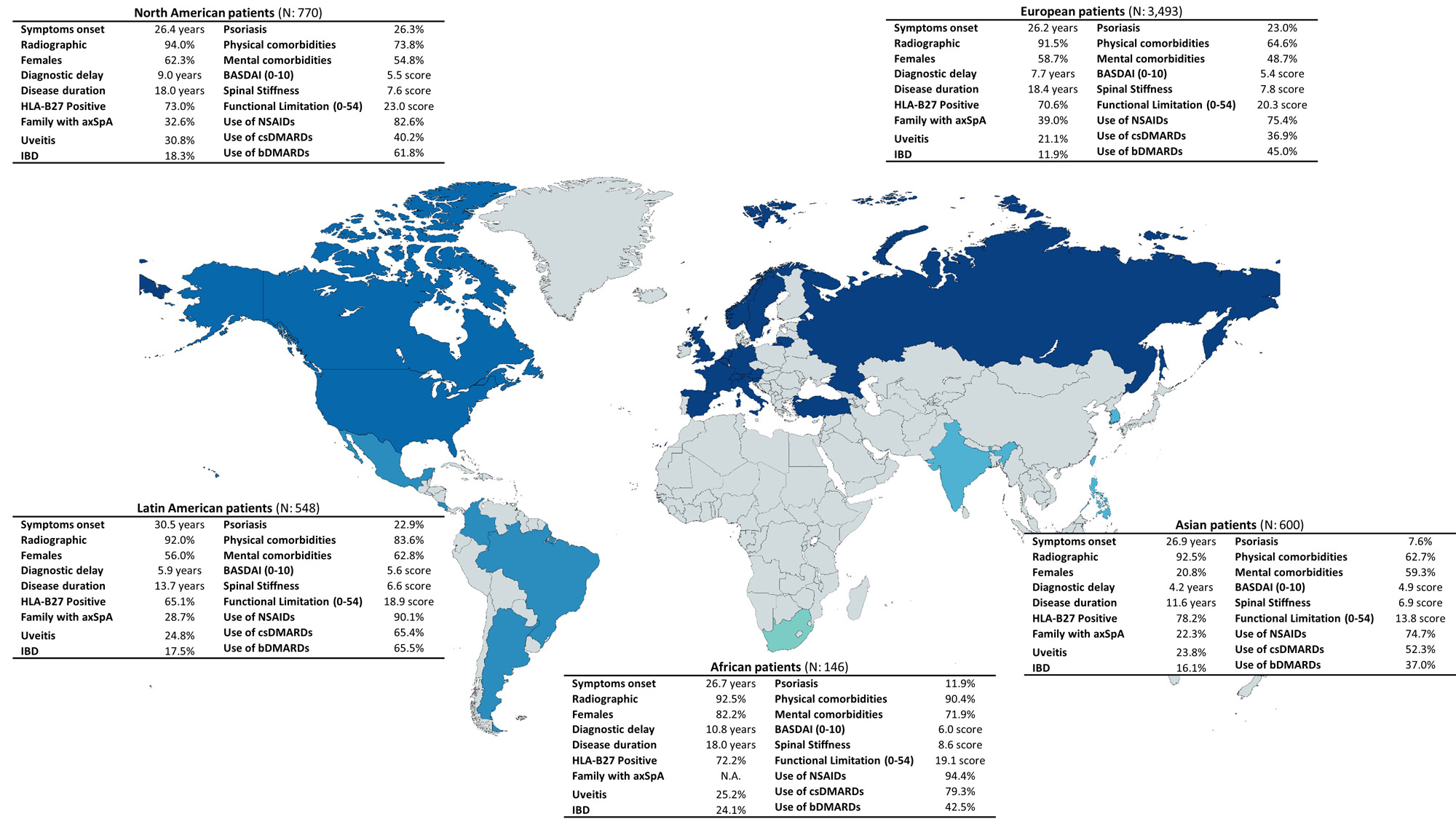Session Information
Session Type: Poster Session C
Session Time: 9:00AM-11:00AM
Background/Purpose: Previous studies have suggested there could be regional differences in clinical phenotype of axial spondyloarthritis (axSpA). This analysis aims to explore differences in axSpA clinical phenotype around the world in a large sample of patients included in the International Map of Axial Spondyloarthritis (IMAS).
Methods: IMAS was a cross-sectional online survey (2017-2022) of 5,557 unselected axSpA patients from 27 countries. We analysed across 5 geographic regions the age at onset of symptoms, classification as radiographic or non-radiographic, gender, HLA-B27, axSpA family history, extra-musculoskeletal manifestations (uveitis, inflammatory bowel disease and psoriasis), presence of comorbidities, disease activity (BASDAI), level of spinal stiffness, and treatment (NSAIDs, csDMARDs and bDMARDs). Kruskal-Wallis and chi-square test were used to compare axSpA characteristics across the regions.
Results: 5,557 patients participated in IMAS survey of which 3,493 were from Europe, 770 from North America, 600 from Asia, 548 from Latin America, and 146 from Africa. Results showed statistically significant differences between regions, except for the classification status (radiographic or non-radiographic). Age at onset of symptoms ranged between 25-30 years, and was higher in Latin America as compared to other regions. Diagnostic delay was longest in South Africa and lowest in Asia. The lowest frequency of HLA-B27 positivity was observed in Latin America and the highest in Asia. Family history of SpA was most often recorded in Europeand less often in Asia. All extra-musculoskeletal manifestations included were lowest in Europe compared with other regions. Physical and mental comorbidities were frequent in African patients and less common in Europe and Asia. Mean disease activity (BASDAI) was 5.4, with highest values in South Africa and lowest in Asia. Spinal stiffness was highest in South Africa and lowest in Latin America. Functional limitation was higher in North America and Europe and lower in Asia. Most of the patients had used NSAIDs for their condition and less than half had ever taken csDMARDS; both were more frequent in Latin America and South Africa. Almost half of the patients had ever taken bDMARDs, more frequent being in the Americas (Map 1).
Conclusion: There is great heterogeneity of axSpA clinical phenotype presentation around the world. Further understanding of these differences is needed to achieve early diagnosis and initiation of disease treatment in axSpA.
To cite this abstract in AMA style:
Poddubnyy D, Sommerfleck F, Navarro-Compán V, Bundy C, Makri S, Murlidhar Akerkar S, Wermskog L, Karam E, Correa Fernandez J, Siddiqui A, Garrido-Cumbrera M. Regional Differences in Clinical Phenotype of Axial Spondyloarthritis. Results from the International Map of Axial Spondyloarthritis (IMAS) [abstract]. Arthritis Rheumatol. 2023; 75 (suppl 9). https://acrabstracts.org/abstract/regional-differences-in-clinical-phenotype-of-axial-spondyloarthritis-results-from-the-international-map-of-axial-spondyloarthritis-imas/. Accessed .« Back to ACR Convergence 2023
ACR Meeting Abstracts - https://acrabstracts.org/abstract/regional-differences-in-clinical-phenotype-of-axial-spondyloarthritis-results-from-the-international-map-of-axial-spondyloarthritis-imas/

